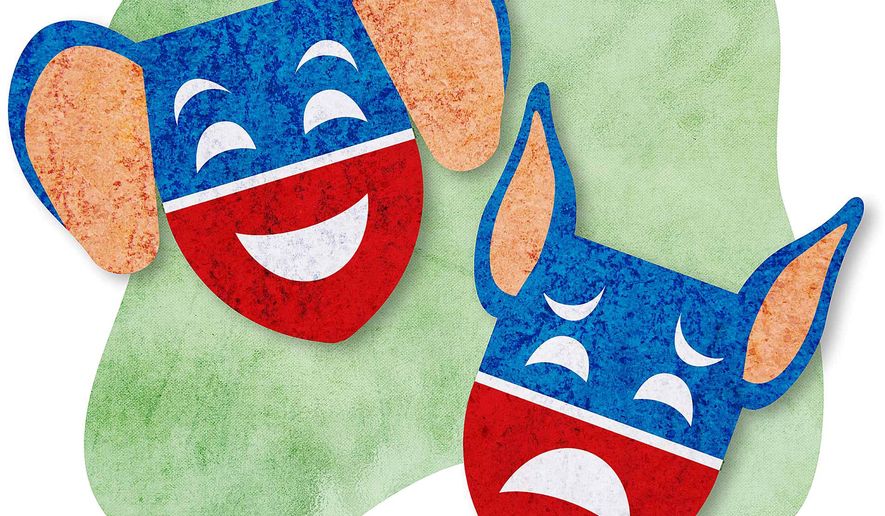OPINION:
Though a long time returning, Republicans apparently again have a pulse. A combination of negative Democratic and positive Republican factors show midterms may not be the “GOP D.O.A.” they once seemed. The two parties have again come together from different directions: Democrats have negated their positive, while Republicans have neutralized their negative.
Rasmussen’s Wednesday generic congressional ballot poll showed Republicans and Democrats tied at 44 percent. Republicans have not been so close in three months. Just a week ago, the Democrats’ lead was seven points.
While perhaps an aberration, the tie reveals a clear trend: Democrats are slowing and Republicans are closing. Democrats started this midterm race with two big advantages: Election history and Trump’s presidency.
It is a given in American politics that the president’s party loses seats when he is off the ballot. As the promise of candidacy becomes the compromise of presidency, popularity suffers. Reality and responsibility combine: Disappointed voters of the losing candidate remain opposed, and with every tough decision, some winning candidate supporters become disgruntled. Following two years later, the president’s party in Congress feels the effect.
To this general midterm predicament, Republicans had a particular one: This president. His acerbic style, aggressive policy agenda and administration missteps exacerbated their midterm malaise. Not long ago, this combination had Republicans so far behind they had trouble even seeing the Democrats.
However, as Rasmussen’s generic ballot tie demonstrates, Democrats have largely fumbled their general and particular advantages. A large reason is that their left has them going backward. Another is that, having been in reverse, President Trump and Republicans have begun going forward.
Extreme liberals continue to present an increasingly negative face for Democrats. As the left has grown more motivated against Mr. Trump, they have grown more strident and aggressive. And increasingly, and publicly, confrontational.
With three-fourths of America’s electorate moderates and conservatives (according to 2016 presidential election exit polling), this turns away from the general electorate Democrats need to attract. However, Democrats are stuck: Always dependent on liberals for core support, they are now especially so for their energy and motivation. For Democrats, extreme liberals are literally offering them a vicious cycle.
Simultaneously, Republicans have shifted out of reverse. Mr. Trump’s job approval rating, according to Rasmussen’s Aug. 22 daily polling, stood at 46 percent approval to 52 percent disapproval. While still negative, Mr. Trump only won 46 percent of 2016’s popular vote — in other words, he is essentially where he was when he won.
The economy has also been extremely positive. Already much stronger than President Obama’s, the second quarter’s 4.1 percent real growth rate punctuated that strength. As tax cut critics have pointed out, that legislation has not generated widespread approval; however, it does provide Republicans a tangible accomplishment to point to for the economy’s robust performance. What popularity the tax cut may lack, the economy provides.
The notable shift in the public’s perception of the country’s direction demonstrates the impact. Rasmussen’s right track/wrong track barometer this week read 43 percent/52 percent. Not only very close to Mr. Trump’s job approval rating, it is markedly better than this barometer’s reading under Mr. Obama. The comparable reading in August 2010, was 28 percent/67 percent. And Mr. Obama’s reading remained remarkably dismal: Just before 2016’s election, it read 27 percent/66 percent.
Just over two months ahead of November’s midterms, the two parties are moving in opposite directions and toward each other. Democrats, driven by dependence on the left, are moving back from the general and particular advantages they once held not long ago. Republicans, led by a strong economy shifting America from anxiety to prosperity, and a president, who is at least back where he started, have rebounded.
Of course, a poll is not an election — especially a midterm comprising over 400 Congressional races nationwide. Is it just an anomaly, where things appear closer than they are? Even so, it still shows things are far closer than they were.
Nor do events stop unfolding. How do recent convictions of two top Trump aides affect the electorate? Dismissing any potential future legal ramifications, do these convictions alter public perception? Perhaps, but clearly public perception has been more focused on presidential performance more than personality.
For those expecting to see Washington’s gridlock resolved, it is clear the parties continue unable to significantly separate. In retrospect, the 2016 race was a dead-heat — though unknown until the end. Any gap 2017 seemed to presage — brought on by a divergence of Democrats’ large potential and Republicans’ large liability — now appears gone. If any is to occur, the next two months will have to provide what the last two years has not.
• J.T. Young served in the Treasury Department and the Office of Management and Budget.




Please read our comment policy before commenting.